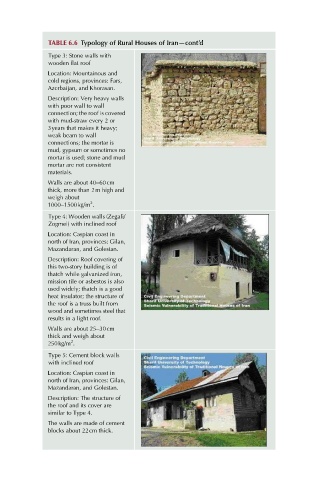Page 481 - Advanced Design Examples of Seismic Retrofit of Structures
P. 481
TABLE 6.6 Typology of Rural Houses of Iran—cont’d
Type 3: Stone walls with
wooden flat roof
Location: Mountainous and
cold regions, provinces: Fars,
Azerbaijan, and Khorasan.
Description: Very heavy walls
with poor wall to wall
connection; the roof is covered
with mud-straw every 2 or
3years that makes it heavy;
weak beam to wall
connections; the mortar is
mud, gypsum or sometimes no
mortar is used; stone and mud
mortar are not consistent
materials.
Walls are about 40–60cm
thick, more than 2m high and
weigh about
2
1000–1500kg/m .
Type 4: Wooden walls (Zegali/
Zogmei) with inclined roof
Location: Caspian coast in
north of Iran, provinces: Gilan,
Mazandaran, and Golestan.
Description: Roof covering of
this two-story building is of
thatch while galvanized iron,
mission tile or asbestos is also
used widely; thatch is a good
heat insulator; the structure of
the roof is a truss built from
wood and sometimes steel that
results in a light roof.
Walls are about 25–30cm
thick and weigh about
2
250kg/m .
Type 5: Cement block walls
with inclined roof
Location: Caspian coast in
north of Iran, provinces: Gilan,
Mazandaran, and Golestan.
Description: The structure of
the roof and its cover are
similar to Type 4.
The walls are made of cement
blocks about 22cm thick.

